Geoscience Reference
In-Depth Information
6.2. Winds
The major forces acting on the air in the horizontal are
the PGF, ACoF, FF, and ACfF. In the vertical, the major
forces are the upward-directed vertical pressure gradi-
ent force and the downward-directed force of gravity.
These forces drive winds. Examples of horizontal winds
arising from force balances are given next.
North Pole
B
B'
C
Direction
of the earth's
rotation
A
D
A'
Equator
West
East
H
E
E'
6.2.1. Geostrophic Wind
The type of wind involving the least number of forces is
the
geostrophic
(“Earth-turning”)
wind
.Thiswindis
driven by only the pressure gradient force and the appar-
ent Coriolis force. It occurs above the boundary layer,
where surface friction is negligible, and along straight
isobars, where the apparent centrifugal force is negligi-
ble. An
isobar
is a line of constant pressure drawn on
a constant altitude map. Suppose a horizontal pressure
gradient, represented by two parallel isobars, exists,
such as at the top of Figure 6.2. The PGF causes still air
to move from high to low pressure. As the air moves,
the ACoF deflects the air to the right in the North-
ern Hemisphere. The ACoF continues deflecting the air
until the ACoF exactly balances the magnitude and is
in the opposite direction from the PGF. This condition
is referred to as
geostrophic balance
.Figure 6.2 shows
that the resulting wind (the geostrophic wind) flows par-
allel to the isobars. The closer the isobars are together,
the faster the geostrophic wind. In reality, geostrophic
balance occurs following a process called
geostrophic
adjustment
, during which the wind overshoots and then
undershoots its ultimate path in an oscillatory fash-
ion. In the Southern Hemisphere, the ACoF deflects
G
F
F'
South Pole
Figure 6.1.
Example of the apparent Coriolis force
(ACoF), described in the text. Thin arrows represent
intended paths, and thick arrows are actual paths.
will appear as if it has been deflected to the right (from
point B
to point C). Similarly, an object thrown from
point B to point A in the south will end up at point D,
instead of at point A
,bythetime the person at point B
reaches point B
.The Coriolis effect, therefore, appears
to deflect moving bodies to the right in the Northern
Hemisphere and to the left in the Southern Hemisphere.
6.1.3. Friction Force
Athirdforce that acts on moving air, the
friction force
(FF), is important near the surface only. The FF slows
the wind. Its magnitude is proportional to the wind
speed, and it acts in exactly the opposite direction from
the wind. The rougher the surface, the greater the FF.
The FF over oceans and flat deserts is small, whereas
that over forests and buildings is large.
PGF
L
6.1.4. Apparent Centrifugal Force
Afourth force, which also acts on moving air, is
the
apparent centrifugal force
(ACfF). This force is
another fictitious force; it arises when an object rotates
around an axis. The apparent force is directed outward,
away from the axis of rotation. When a passenger in a
car rounds a curve, for example, a viewer traveling with
a passenger sees the passenger being pulled outward,
away from the axis of rotation, by this force. In contrast,
aviewer fixed in space sees the passenger accelerat-
ing inward due to a
centripetal acceleration
,which is
equal in magnitude to, but opposite in direction from,
the apparent centrifugal force.
Aloft
Geostrophic wind
H
ACoF
PGF
L
Surface wind
Surface
FF
H
ACoF
FF+ACoF
Figure 6.2.
Forces acting to produce winds aloft and
at the surface in the Northern Hemisphere.































Search WWH ::

Custom Search